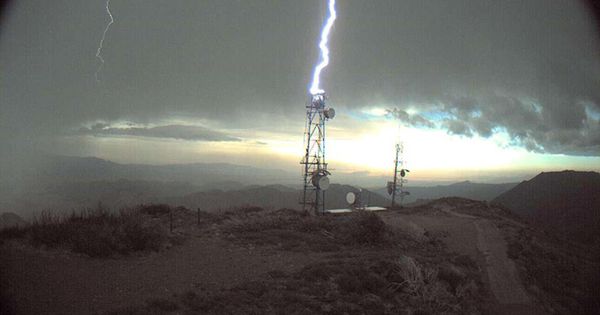
A Guide For Debunking Lightning Myths
I saw an interesting story in the Capital Weather Gang of the Washington Post about a man walking with an umbrella. He was almost struck by a bolt of lightning. The “shocking” video is available at this link. The lesson from that ordeal is to avoid being outside and exposed during a thunderstorm. There is really no safe place outdoors. Two people asked me why umbrellas attract lightning. This is actually a myth. Herein, I explain why it is a myth and debunk other common myths about lightning.

A lightning strike of a tower
NOAA
For a full explanation of how lightning forms, I recommend my piece in Forbes at this link. Lightning often strikes tall structures such as metal poles, antennas, trees, and buildings. The atmosphere is a very good insulator so lightning seeks the path of least resistance. For this reason, we often advise you to get inside if possible. If that is not an option, then get as low as possible and avoid being near a “path of least resistance” or becoming one yourself. There is nothing about an umbrella that makes it an “attractor” of lightning. Metal doesn’t necessarily attract lightning but it is certainly a good conductor of it electricity, which means that your location and timing during an electrical storm are key factors to consider. If you are near structure (or become the source) of positive ions (see below) in the lightning stroke process, a dangerous situation can unfold. To be clear, I am not saying holding an umbrella isn’t dangerous (It is). I am simply trying to clarify the myth that it “attracts.”

How a lightning stroke forms
National Weather Service
Another myth about lightning is that golfers are struck more by lightning. This makes sense sense because they roam around a course with lots of trees holding long metal objects. While there is significant danger to golfers during thunderstorms, fisherman are statistically more likely to be struck by lightning. John Jensinius is a lightning expert with the National Lightning Safety Council and author of a March 2019 entitled, “A Detailed Analysis of Lightning Deaths in the United States from 2006 through 2018.” It is available on the National Weather Service website. Key findings from the report are summarized in the abstract:
During this 13-year period fishermen accounted for more than three times as many fatalities as golfers, while beach activities and camping each accounted for about twice as many deaths as golf. From 2006 to 2018, there were a total of 38 fishing deaths, 23 beach deaths, 19 camping deaths, and 17 boating deaths. Of the sports activities, soccer saw the greatest number of deaths with 12, as compared to golf with 10. Around the home, yard work (including mowing the lawn) accounted for 18 fatalities. For work-related activities, ranching/farming topped the list with 19 deaths.

Lightning fatalities by gender from 2009 to 2019
National Weather Service
While these results may be surprising, there were other results that were not. For example, males account for more than 80% of the fatalities, and weekends are the time of week most likely to experience a lightning fatality.
My colleague Dr. Kevin Kloesel at the University of Oklahoma told me on an episode of the Weather Geeks podcast that he prefers to call storms “lightning storms” rather than thunderstorms because that highlights the actual danger. The cute slogan “When The Thunder Roars, Go Indoors” is commonly used, but perhaps we need something with a more direct link to the actual hazard: “When you see lightning flash, you should dash” or “A lightning strike could take your life.”
Speaking of myths, you are not completely safe indoors. About one-third of lightning strike injuries happen indoors. In fact, earlier this month lightning struck a house in Florida causing a toilet to explode. It is wise to stay away from plumbing (usually metal piping) or electrical equipment because they conduct electricity. Concrete walls or flooring can also be dangerous because they often have metal rods or framing for support. While the era of cellular or cordless phones is here, some people still have corded phones. I actually keep at least one in my house in case of a power outage. If it is lightning, stay off of those phones too.
The National Weather Service has an excellent report on its website with a host of good information on storms and lightning. The graphic below is from that website, and it provides some potentially illuminating myth-busting about lightning.

Lightning fact or fiction
National Weather Service






